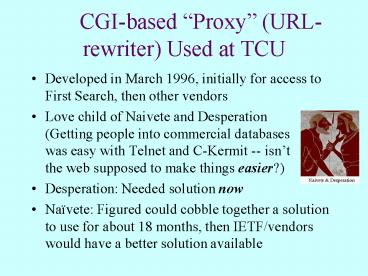CGI-based - PowerPoint PPT Presentation
Title:
CGI-based
Description:
CGI-based Proxy (URL-rewriter) Used at TCU Developed in March 1996, initially for access to First Search, then other vendors Love child of Naivete and Desperation – PowerPoint PPT presentation
Number of Views:56
Avg rating:3.0/5.0
Title: CGI-based
1
CGI-based Proxy (URL-rewriter) Used at
TCU
- Developed in March 1996, initially for access to
First Search, then other vendors - Love child of Naivete and Desperation(Getting
people into commercial databaseswas easy with
Telnet and C-Kermit -- isntthe web supposed to
make things easier?) - Desperation Needed solution now
- Naïvete Figured could cobble together a solution
to use for about 18 months, then IETF/vendors
would have a better solution available
2
Goals...
- Support following vendor authorization scenarios
with one program - User enters id/password in a form to gain access
(Cambridge Scientific Abstracts, Ovid on TexShare
server, OCLC) - Vendor uses standard HTTP Username/Password
validation (Hoovers Company Data, CenStats) - Vendor validates based on IP address (many
vendors) - Make completely transparent to user (no
reconfiguration of Web browser) - Use tools we already had (e.g, not maintain a
Unix box just to run WebScript)
3
Tools
- The Lynx Web browser supports most validation
scenarios as long as vendor doesnt require use
of cookies (many systems send cookies, but still
work without them) - URL re-writing technique makes access transparent
to User - no reconfiguration of browser. - Components are CERN Web server on VMS, CGI
scripts written in DCL, the Lynx web browser, and
a Pascal URL-rewriter program written in-house
(tools we already had, except for URL-rewriter)
4
How it works (IP validation scenario)
- User clicks on a link to a URL that looks like
this - http//lib.tcu.edu/htbin/validate.pp?Britannica
- Validate.pp looks at WWW_REMOTE_ADDR field to
determine if user is already coming from a TCU IP
address - If FLoc("138.237", WWW_REMOTE_ADDR) .lt.
FLen(WWW_REMOTE_ADDR) - then
- WS "Location http//www.eb.com180/"
- WS ""
- else
5
. (IP validation scenario)
- If user is off-campus, then send them back a
screen explaining theyre about to be asked for
username and password, with a link that calls the
CGI script for remote resource. URL for the link
looks like this - http//lib.tcu.edu/htbin/Britannica.pp?http//www.
eb.com180/ - If their username and password isregistered,
Britannica.pp uses Lynxto fetch the page
specified as the parameter and dumps it in a
temp file.
6
. (IP validation scenario)
- Pascal program opens the temp file and looksfor
all HREF, SRC and other tags thatspecify URLS.
If URL is relative - ltIMG SRC/images/pascal.jpggt
- Then it must first be converted to absolute
formltIMG SRChttp//www.eb.com180/images/pasca
l.jpggt - Then, assuming URL points to something that also
requires IP validation, the URL of the CGI script
is prepended to itltIMG SRChttp//lib.tcu.edu/h
tbin/britannica.pp?http//www.eb.com180/images/pa
scal.jpggt
7
. (IP validation scenario)
- So, when user clicks on the link (or when browser
fetches data automatically, as with IMG tags),
access continues to be routed through the CGI
script and the vendors server continues to see
our IP address. Lynx will gladly fetch .JPG,
.GIF, .PDF and other non-HTML data and dump it in
a temp file, so the CGI script just does a
redirect when it sees that its fetched non-HTML
data - If (FLoc(".GIF", TSTR) .lt. FLen(URL)) .OR.
(FLoc(".JPG", TSTR) ... - then
- WS "Location http//library.tcu.edu/wwwscra
tch/''HTML_InFile'" - WS "
- else
8
Surprisingly...
its worked for three years
- Currently in use for 18 different sources. Most
use IP validation, three use HTTP
Username/Password, and five use logon forms with
session ids.
- 250-1,400 files a day fetched through the
scripts in February.
- Although technique is clunky (creates temporary
files for everything fetched), the response time
for the Internet is generally so slow that the
extra time required by the scripts is negligible
in comparison. Likewise, the load it adds to our
Alpha server is small relative to other
applications.
9
But
- Lack of cookie support is becoming anissue for
more and more databases. - Creating scripts requires fair amount of
proficiency in DCL. - Limitations in DCL and Lynx create need for some
kludgy work arounds in some of the DCL scripts
they can be complex to diagnose when something
stops working. - How much longer will be be running a VMS server?
10
So working on a new version.
- Written as a Java Servlet so as to be portable
to different web servers andoperating systems.
(The Servlet interface replaces CGI). - Instead of scripts, uses a configuration file
should be easier to set up and maintain. - Java has built in support for cookies and
maintaining state in both directions (to the
vendor, and to the users browser), so cookie
support becomes doable.
11
Finally.
- If vendors start supporting a bettersolution,
like theReferrer URLtechnique, there will be
no need for it. Altogethernow, lets
startholding our breath...

